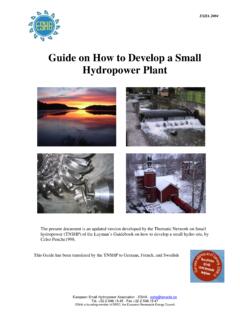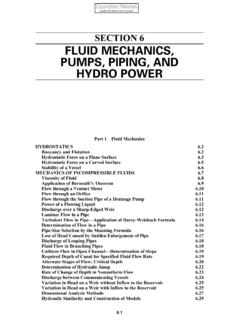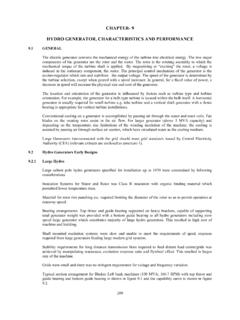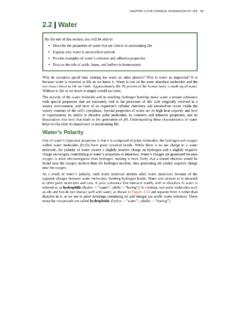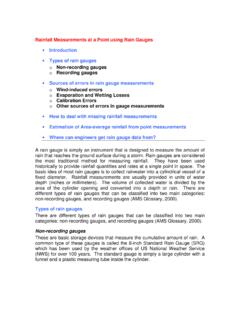Transcription of An Introduction to Hydropower Concepts and ... - Canyon …
1 An Introduction to Hydropower Concepts and Planning Copyright Canyon Industries, Inc. All rights reserved. Guide to hydro Power Guide to Hydropower Table of Contents Welcome! .. 3 Part 1: hydro Systems 4 How Water Power Works .. 4 Power Conversion & Efficiency .. 4 Major Components of a hydro System .. 5 Water Diversion (Intake) .. 5 Pipeline (Penstock) .. 5 Powerhouse .. 5 Turbines and 6 Turbine .. 6 Drive System .. 7 Generator .. 8 System 9 Governors and Controls .. 9 Electronic Load 9 Load Management Systems .. 10 Emergency System Shutdown .. 10 Utility Grid Interface Controls .. 11 Part 2: Planning Your Own hydro System .. 12 The Four Things You Need to 12 Measuring Head and Flow .. 12 Measuring Head .. 12 Measuring Flow .. 14 How the Penstock Affects Head Pressure.
2 18 Measuring Pipeline (Penstock) Length .. 18 Computing Net 18 Calculating the Power in Your Stream .. 20 Computing Water Power .. 20 Adjusting for Efficiency Losses .. 21 Measuring Transmission Line Length .. 21 Part 3: Evaluating Turbine Systems and What Makes a Quality Turbine 22 Turbine Runner .. 22 Turbine Housing .. 22 Other Turbine Considerations .. 23 Turbine Supplier .. 23 Closing 24 Copyright Canyon Industries, Inc. All rights reserved .Page 2 Guide to hydro Power Welcome! Canyon hydro has developed this Guide to hydro Power to help you gain a basic understanding of how home power micro- hydro systems work, and what goes into the design. We ve tried to keep the content objective and hype-free, so you won t see information about Canyon hydro systems specifically.
3 (But we do hope you keep us in mind when you re ready to buy your hydro system.) If you re just starting out, we think you will find this information extremely helpful. If you re already a senior hydro engineer, you may be more interested in Canyon s Utility/IPP Systems. We ve divided our Guide to hydro Power into three major sections: hydro Systems Overview, a discussion of how hydro power works, and a look at the major components that make up a hydro system. Planning Your Own hydro System, including how to measure Head and Flow, adjusting for pipeline losses, and computing power output. Evaluating Turbine Systems and Suppliers, including tips for evaluating quality, reliability and customer service. You won t learn everything you need to know to design your own system, but our engineers will be happy to help you when you re ready.
4 All we ask is that you have accurate measurements of your Head and Flow, and we ll take it from there. This Guide will show you how. I hope you find this information useful. If you have comments or suggestions about the content within this Guide, please let us know at Daniel A. New President Copyright Canyon Industries, Inc. All rights reserved .Page 3 Guide to hydro Power Part 1: hydro Systems Overview How Water Power Works Water power is the combination of HEAD and FLOW. Consider a typical hydro system. Water is diverted from a stream into a pipeline, where it is carried downhill and through the turbine (FLOW). The vertical drop (HEAD) creates pressure at the bottom end of the pipeline. The pressurized water emerging from the end of the pipe creates the force that that drives the turbine.
5 More FLOW, or more HEAD, produces more power. HEAD and FLOW are the two most important things you need to know about your site. You must have these measurements before you can seriously discuss your project, the power it will generate, or the cost of components. As you will see, every aspect of a hydro system revolves around Head and Flow. Remember: HEAD is water pressure, which is created by the difference in elevation between the water intake and the turbine. HEAD can be expressed as vertical distance (feet or meters), or as pressure, such as pounds per square inch (psi). Net Head is the pressure available at the turbine when water is flowing, which will always be less than the pressure when the water is turned off. As we ll discuss later, pipeline diameter has a major effect on Net Head.
6 FLOW is water quantity, and is expressed as volume per second or minute such as gallons per minute (gpm), cubic feet per second (cfs) or liters per second (lps). Both HEAD and FLOW must be present to produce water power. Design Flow is the maximum FLOW for which your hydro system is designed. It will be less than the maximum Flow of your stream (especially during rainy season), and is often a balance between power output and cost. Net HEAD and Design FLOW are used to specify hydro system components. The importance of accurate Head and Flow measurements cannot be overemphasized. Later in this Guide, we ll discuss How to Measure Head and Flow. Power Conversion & Efficiency In reality, the generation of electricity is simply the conversion of one form of power to another.
7 The turbine converts water power into rotational power at its shaft, which is then converted to electrical power by the generator. It is important to note: Power is never created; it can only be converted from one form to another Some of the power will be lost through friction at every point of conversion. Efficiency is the measure of how much energy is actually converted. The simple formula for this is: Net Power = Gross Power x Efficiency While some power losses are inevitable as water power gets converted to electricity, they can be minimized with good design. Each aspect of your hydro system, from water intake to turbine-generator alignment, affects efficiency. Turbine design is especially important; a good turbine supplier will work closely with you to specify a turbine with dynamic operating characteristics that match your Head and Flow.
8 Copyright Canyon Industries, Inc. All rights reserved .Page 4 Guide to hydro Power Major Components of a hydro System A hydro system is a series of interconnected components: water flows in one end, and electricity comes out the other. This section provides a high-level overview of these components, from the water source to voltage and frequency controls. Water Diversion (Intake) The intake is typically the highest point of your hydro system, where water is diverted from the stream into the pipeline that feeds your turbine. In many cases a small dam is used to divert the water. (In most large hydro projects, the dam also creates the HEAD necessary to drive the turbine.) A water diversion system serves two primary purposes. The first is to provide a deep enough pool of water to create a smooth, air-free inlet to your pipeline.
9 (Air reduces horsepower and can cause damage to your turbine.) The second is to remove dirt and debris. Screens can help stop larger debris such as leaves and limbs, while an area of quiet water will allow dirt and other sediment to settle to the bottom before entering your pipeline. This helps reduce abrasive wear on your turbine. Major components of a hydro system include a water diversion, pipeline to create pressure, turbine & generator, tailrace for exiting water, and transmission (Penstock) The pipeline, sometimes called the penstock, is responsible for not only moving water to your turbine, but is also the enclosure that creates Head pressure with increasing vertical drop. In effect, the pipeline focuses all the water power at the bottom of the pipe where your turbine will connect.
10 In contrast, an open stream dissipates the energy as it travels down the hill. Pipeline diameter, length, and routing all affect efficiency, and there are guidelines for matching the size of your pipeline to the Design FLOW of your system. As you ll see later, a small -diameter pipeline can considerably reduce your available horsepower, even though it can carry all available water. Larger diameter pipelines create less friction as the water travels through. Powerhouse The powerhouse is simply a building that houses your turbine, generator and controls. Proper design significantly affects system efficiency, however, especially with regard to how the water enters and exits your turbine. This stainless steel intake system includes a self-cleaning screen. Copyright Canyon Industries, Inc.
